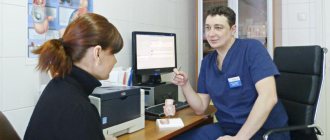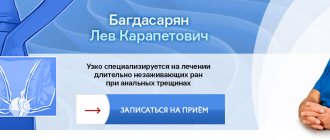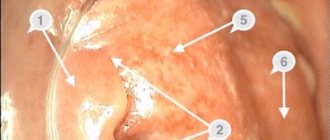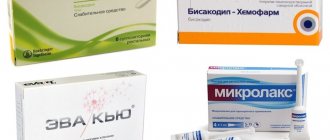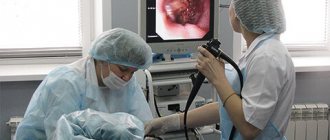Hemorrhoids are a vascular disease in which dilation of the hemorrhoidal veins of the rectum is observed, causing the formation of characteristic hemorrhoids that cause pain and bleeding in patients.
Diagnosis of hemorrhoids is not difficult: more than 90% of cases are determined during a digital examination of the anus and do not require the use of instrumental research methods.
Causes
The root cause of hemorrhoids is a violation of the inflow and outflow of blood in the cavernous bodies of the rectum. Normally, the corpora cavernosa (also called cavernous bodies) help control the urge to defecate: when filled with blood, they “swell” and help retain feces in the intestines, and after a successful bowel movement, blood flows out and the corpora cavernosa shrink.
If the inflow/outflow regulation is disrupted and the corpora cavernosa have been engorged with blood for a long time, this causes the vascular walls to dilate and thin, making them much more susceptible to rupture or erosive lesions, which in turn cause inflammation and can lead to blood clots.
Factors that provoke venous stagnation
The following predisposing factors can provoke long-term venous congestion in the corpora cavernosa:
- Physical inactivity.
A low level of physical activity (due to sedentary work or simple laziness) causes extensive disturbances of venous blood flow throughout the body - and in the rectum in particular.
- High loads.
Ultra-high physical activity associated with lifting weights causes excessive tension in the abdominal muscles and rectal area, which also leads to disturbances in the venous blood flow.
- Chronic constipation.
The presence of feces in the rectum causes a constant, permanent filling of the cavernous bodies with blood, as mentioned above.
- Venous pathologies.
Impaired blood flow in hemorrhoidal veins can be caused by various vascular diseases.
- Oncology.
Tumor formations in the rectum cause disturbances in the inflow/outflow of blood due to mechanical compression of the venous vessels or their deformation due to tumor growth (in later stages).
- Diarrhea.
Severe diarrhea, especially caused by poisoning or infectious diseases, causes congestion of the venous system of the rectum, which leads to dilation of blood vessels or even micro-ruptures, followed by an inflammatory process.
- Pregnancy and childbirth.
Bearing and giving birth to a child is often accompanied by multiple disturbances in the pelvic venous circulation system, which can (but not necessarily) lead to the appearance of hemorrhoids.
- Obesity.
The presence of excess weight, by analogy with physical inactivity, also leads to multiple disturbances of venous blood flow.
- Bad habits.
Chronic alcohol abuse or long-term tobacco smoking provokes varicose veins, which primarily affects the pelvic region and lower extremities.
- Heredity.
Low hereditary elasticity of the venous vessels of the rectal area creates a predisposition to hemorrhoidal disorders - although it is not considered as their direct cause.
Effective treatment for hemorrhoids
If symptoms are not expressed or an exacerbation occurs for the first time, a competent doctor-proctologist will advise conservative measures, which will include:
- treatment of hemorrhoids with medication. Using a local set of ointments, suppositories, baths;
- it is necessary to normalize the “stool” - sufficient fiber consumption (vegetables, fruits, cereals), sufficient water consumption up to 1.5 -2.0 liters, activation of the motor mode (walking, playing sports);
- refusal of dry toilet paper in the anal area and use of warm water or a shower after defecation;
- They recommend wheat bran, seaweed and flaxseed in their natural form, or in the form of pharmaceuticals, seeds and psyllium husks, which have a high water-holding capacity, and this allows you to avoid straining during bowel movements.
In case of chronic recurrent course of the disease with 1 - 2 degrees of internal hemorrhoids, it is possible to apply latex rings to hemorrhoids:
The procedure is performed quickly and almost painlessly: a latex ring is applied to the hemorrhoidal nodes, which leads to disruption of the blood supply and “drying out” of the node, and in 4-5 days it “disappears” on its own. During one procedure, you can apply 1 - 2 rings. Sometimes 3 to 5 procedures may be required. Possible complications: bruising and pain (usually do not require additional interventions).
Minimally invasive procedures include:
- infrared coagulation (laser treatment of hemorrhoids);
- radiofrequency coagulation;
- cryo-treatment of hemorrhoidal venous plexuses.
All of them are aimed at eliminating the blood supply to the hemorrhoidal plexuses and reducing hemorrhoids.
Symptoms
The main signs of hemorrhoids are bleeding from the anus, as well as pain, itching and discomfort in the rectal area. The severity of symptoms differs depending on the form of the disease (acute or chronic), as well as its stage (neglect).
Signs of chronic hemorrhoids
The nature of the symptoms is determined by the stage of the disease:
- Stage 1.
As a rule, there are no disturbing signs, and the presence of hemorrhoids can only be detected with targeted research. In rare cases, patients complain of occasional pain and itching in the anus or minor traces of blood on toilet paper.
- Stage 2.
Visually visible and easily palpable hemorrhoids appear, which still retain a certain “elasticity” and therefore do not fall out of the rectum. Bleeding, pain, itching and discomfort in the rectal area do not always bother patients; sometimes the disease is still asymptomatic.
- Stage 3.
Hemorrhoids protrude and often bleed. Pain and itching become constant, intensifying with bowel movements or physical activity. Thrombosis of hemorrhoidal veins may occur.
- Stage 4.
Hemorrhoids become large, constantly hurt and bleed. Primary signs of tissue necrosis may also be observed.
Symptoms of acute hemorrhoids
The acute form of hemorrhoids occurs against the background of complete or relative well-being, when there were no hemorrhoidal formations at all or if the disease was asymptomatic. The transition to the acute stage is accompanied by the following symptoms:
- sudden sharp pain, most often occurring during bowel movements;
- heavy bleeding as a result of rupture of a venous vessel;
- severe itching and discomfort that does not disappear even after completion of the bowel movement;
- the appearance of visible and severely inflamed hemorrhoids - if these have not been observed before.
Diagnostics
Even with a visual examination, the doctor can figure out what the problem is with external hemorrhoids. The so-called hemorrhoidal cones will not allow you to doubt the correctness of the diagnosis. Treatment of internal hemorrhoids first involves digital examination in order to assess the condition of the internal nodes. Sometimes, if diseases in the upper intestine are suspected (for example, polyps) or to exclude cancer, anoscopy or sigmoidoscopy (visual examination of the lower intestine using a flexible endoscope) may be required.
Medical care for patients at Medical Plaza MC is developing along the path of minimizing surgical interventions. If 20 years ago, surgeons had one operation for hemorrhoids in their arsenal - the classic Milligan-Morgan operation (excision of hemorrhoids with suturing of the feeding vessels), today advertisements on all sites are replete with an abundance of new minimally invasive, “non-surgical” techniques, which are also popular Treatment of hemorrhoids is conservative.
What should pregnant women and postpartum women/mothers with acute thrombosis do?
According to statistics, about a quarter of pregnant women and almost half of postpartum women experience various manifestations of hemorrhoidal disease, the most painful of which is acute thrombosis. Usually, postpartum women and especially pregnant women, in response to their complaints to the doctor, hear an offer to be patient. This approach is dictated by the fact that there are many contraindications to the use of the vast majority of medications in pregnant women, and surgical intervention is regarded by the medical community as a factor that can provoke childbirth or stop the process of breastfeeding. In practice, this means that regardless of the severity of the pain syndrome, sometimes very significant, women are forced to remain without any effective treatment. Pain due to thrombosis, in turn, can worsen the psychological state of pregnant or postpartum women and lead to undesirable consequences during childbirth (premature birth) or during breastfeeding (refusal to breastfeeding). Our clinic is a supporter of a personalized approach to the treatment of acute thrombosis in such women. If acute thrombosis categorically prevents the patient from living, it should be actively treated using the entire arsenal of means used in ordinary patients, but taking into account contraindications for medications. In pregnant women in the second and third trimesters, it is possible to perform an operation to remove a thrombosed node (Fig. 7), as well as in postpartum women and women in labor (Fig. 8). During pregnancy, there are some restrictions on the local and general anesthetic drugs that can be used. Specific medications should be selected jointly by both the coloproctologist and the obstetrician so as not to harm the fetus or newborn. The specialists of our Clinic have experience in treating both pregnant and postpartum women with manifestations of acute thrombosis of the hemorrhoid with very good results, reviews of which our patients leave on our website, among other things.
a) b)
Rice. 7. Acute thrombosis of the external hemorrhoid in a 38-week pregnant woman.
Before surgery, pain was rated 8 out of 10, immediately after surgery 3 out of 10.
a) appearance of a thrombosed external hemorrhoid with necrosis, b) appearance after removal of the thrombosed node.
a) b)
Rice. 8. a) acute thrombosis of the external hemorrhoid with severe swelling in the patient on the 5th day after birth, b) the patient’s condition on the 7th day after surgery. On the first day after surgery, pain decreased from 9 to 4 out of 10.
You can read about the treatment of other manifestations of hemorrhoidal disease in pregnant women and postpartum women in the section Hemorrhoids in pregnant women .
How to distinguish acute thrombosis of the external hemorrhoid from other diseases?
Usually, to diagnose acute thrombosis, it is enough to examine the patient and find out how the disease developed and what complaints are of concern. Upon examination, you can see an enlarged (sometimes up to several centimeters) node, often dark red in color, located outside the anus, possibly with a focus of necrosis in the center. When palpating (feeling) in the first few days, you can clearly identify a blood clot in the node; when examined at a later date, the blood clot is no longer so easy to determine; it begins to gradually “dissolve” and is partially replaced by scar tissue. Thrombosis of the external hemorrhoid must be distinguished from
strangulation of a prolapsed internal hemorrhoid. In this situation, prolapse of the internal hemorrhoidal node, normally located inside the anal canal, compression of its pedicle, in which the vessels feeding it pass, and disruption of the blood supply (ischemia) with death of the tissue of the node (Fig. 4 and 5). It is not difficult for a specialist to distinguish between these conditions, but it is quite difficult for a patient to independently understand which node is causing him discomfort. It is important to distinguish between these diseases, as their treatment varies significantly. When an internal hemorrhoid is strangulated, urgent surgical treatment is usually required.
Rice. 4. A strangulated prolapsed internal hemorrhoid with signs of tissue necrosis of the node.
Fig.5. Schematic representation of a strangulated internal prolapsed hemorrhoid.
Acute (exacerbation of chronic) anal fissure - accompanied by the same pain syndrome as with thrombosis, but much more pronounced at the time of bowel movement. With this disease, a rupture of the anal canal mucosa occurs. The appearance of an acute fissure is often associated with a reflex “protective” spasm of the sphincter apparatus, which complicates wound healing. Conservative and surgical treatment of diseases are different.
Acute paraproctitis - similarity with acute thrombosis lies in the appearance of a space-occupying formation in the anus, severe pain. Paraproctitis is an infectious and inflammatory disease with the formation of an abscess (abscess) in the pararectal area. The disease is accompanied by an increase in body temperature and general symptoms of intoxication. A mass formation in the anal canal area is much larger and more painful than with thrombosis. There is often discharge of pus onto the skin or into the lumen of the rectum. Ultrasound examination is used for accurate diagnosis. The disease is extremely dangerous due to the development of chronic purulent fistulas of the perianal area in the absence of adequate and timely treatment.
What causes acute thrombosis of the external hemorrhoid?
The occurrence of thrombosis is often caused by overflow of the veins of the external hemorrhoidal plexus with blood, followed by a slowdown in blood flow in these vessels and the occurrence of blood clots. Thrombosis against the background of venous congestion most often develops after sudden or prolonged stress. Classic examples of such overexertion are heavy lifting, straining during constipation or diarrhea, and childbirth. Chronic stagnation of blood in the pelvic organs (which includes the anal canal) occurs with prolonged sitting, excess body weight, and insufficient physical activity.
Are there ways to prevent relapses/recurrences of the disease?
Prevention of relapse of the disease is based on excluding possible causes of thrombosis. These include hard stools, constipation or diarrhea, “reading on the toilet,” insufficient or, conversely, excessive physical activity (weightlifting, fitness), and prolonged sedentary work. Unfortunately, there are no unambiguous methods for preventing the occurrence of acute thrombosis of the external hemorrhoid; we can only reduce the likelihood of its occurrence, but not completely eliminate it. However, it should be noted that with conservative treatment the likelihood of recurrence of the disease is higher than after operations.
Treatment of hemorrhoids at the Medical Plaza MC clinic
Treatment of hemorrhoids at the Medical Plaza medical center is carried out mainly using the radiofrequency method, which has proven its effectiveness. This method can also be used to treat bleeding hemorrhoids. The procedure is performed under local or spinal anesthesia, lasts up to 20 – 30 minutes and is painless. Observation for up to 2 hours after surgery is sufficient and the patient returns to his usual lifestyle.
For stages 3-4 of internal hemorrhoids, hemorrhoidectomy is performed under spinal anesthesia, which requires the patient to stay in the clinic for one day. During the recovery period, analgesics and suppositories may be required. The standard surgical technique has proven its effectiveness over many years of use.
And finally, for advanced forms of hemorrhoids with prolapse of nodes and rectal mucosa, there is an innovative hardware treatment method (Longo's operation), when a special stapler restores the anatomy of the anal canal while suturing the vessels supplying the hemorrhoidal plexuses. Pain after surgery is minimal, the recovery period is shorter than with standard surgery, and most importantly, the risk of complications is minimized.
It should be noted that only after an examination can a doctor recommend a method that is suitable for your situation.


